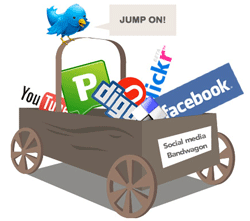
Social bookmarking. Social networking. Blogging. Microblogging. Are you using them all in your social media marketing efforts? What about online video, content aggregators, podcasts, social media news releases, forums, and photo sharing? Some people would have you believe that you should be engaged in all, or most, of these social media tools and tactics to promote your business. Those people are wrong.
Why it Doesn’t Pay to be an Early Adopter
It’s a common marketing misconception that businesses should take advantage of every tool available to them if using that tool could potentially attract new visitors, readers, or customers. While there’s nothing wrong with testing new tools, attempting to try everything may cost more than you’d think (in wasted time), especially if you insist on being one of the first.
When a new social media tool is released, early adopters rush in. From a marketing perspective, being an early adopter is not a smart business move for most businesses. Why? Unless large numbers of your particular target market are also early adopters already using the tool, you’re not going to reach your market by jumping on board. Your marketing message has to reach your actual market. If they’re not there yet, there are more productive ways to spend your (or your employees’) time.
The All-Important ROI
Return on investment (ROI) is one of the most important business concepts out there. In essence, when you maximize your ROI you’re getting as much as you can out of as little as possible.
Let’s say you have $5000 to invest in a social media marketing campaign for the next quarter. You naturally want to get the biggest return possible on that investment (let’s say your goal is to attract more visitors to your website).
You could invest a little bit of that budget into every social media tool you can think of. For example, you might produce a very low-budget video to release on YouTube, hire a part-time blogger to update your company blog and respond to comments, put out one or two social media news releases, hire a forum poster to visit communities to link to your website, and hire someone to help you setup social media and microblogging accounts (such as with Facebook, LinkedIn, and Twitter).
When you try to do too much, your budget is stretched. That video may be much poorer quality than you would have liked. You may get a handful of blog posts for the month instead of a blogger who can post daily and build a real community around your blog. You may have social networking profiles and a Twitter account, but you may not have anyone to constantly update them.
It’s far better to strike a balance. Let’s say you still have a $5000 budget. In this case you choose a more limited campaign plan–a blogger to post several times a week, a piece of linkbait (like a free tool for download from that blog), and one social media press release (which includes social bookmarking options) to announce the release of that new tool.
You may not get as much “stuff” for your $5000, but the targeted approach very often leads to greater returns for the same investment. In this case, you’ll have a populated blog attracting links and readers naturally, a free download which will attract even more links and visitors naturally, and a news release helping to give that tool’s launch an edge by promoting it to other bloggers and members of your target market. The key is the cohesiveness–finding tools and tactics that work well collectively to reach your marketing goals.
Knowing When Enough is Enough
Sometimes trying to get more, or do more, will actually give you less. That’s very true in social media marketing and jumping on the hype of new tools (many of which are fads that die down significantly in just a few months to a few years).
Target your social media marketing campaign not only to tools that actually reach your audience right now, but also to tools that will give you the best return on the time or money you sink in. Your social media marketing plan won’t necessarily look like anyone else’s. Even the most talked-about tool may not be right for your company, your budget, or your potential visitors and customers.
Remember that tried and true marketing strategies have earned that reputation for a reason. Don’t sacrifice promotional efforts that are already successful for your company to pursue new tools that may have a heavy learning curve (meaning more time invested) unless your market research tells you that tool or tactic can work even better than what you’re already doing.
It’s okay to try social media tools as they’re released. Just never forget to find out how your customers are using those tools before you invest in them solely for fear of being left behind.













